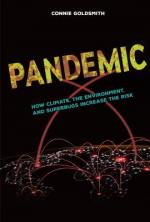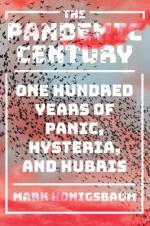January 28, 2020 | sobczakd
The Wuhan coronavirus outbreak is dominating the news of late as health experts try to prevent this deadly virus from becoming an epidemic. So far, there are confirmed cases in the U.S., Australia, Asia and France. Coronavirus is part of a large family of viruses that severely debilitates the respiratory system. Across the U.S. and in China, scientists are racing to create a vaccine. The NIH and WHO recommends the general public heed travel advisories and to seek medical attention if any signs and symptoms appear. Good advice! Want to learn more? Here's some suggestions...
How close are we to having another worldwide health crisis? Epidemiologists predict that another pandemic is coming--one that could kill hundreds of millions of people. Learn about factors that contribute to the spread of disease by examining past pandemics and epidemics. Examine case studies of potential pandemic diseases, and discover how scientists strive to contain and control the spread of disease both locally and globally. See how human activities such as global air travel and the disruption of animal habitats contribute to the risk of a new pandemic. And investigate the challenges we face with antibiotic-resistant bacteria and mutating viruses. Can scientists control the spread of disease and prevent the next pandemic?
Ever since the 1918 Spanish influenza pandemic, scientists have dreamed of preventing catastrophic outbreaks of infectious disease. Yet despite a century of medical progress, viral and bacterial disasters continue to take us by surprise, inciting panic and dominating news cycles. From the Spanish flu to the 1924 outbreak of pneumonic plague in Los Angeles to the 1930 "parrot fever" pandemic, through the more recent SARS, Ebola, and Zika epidemics, the last one hundred years have been marked by a succession of unanticipated pandemic alarms.In The Pandemic Century, a lively account of scares both infamous and less known, Mark Honigsbaum combines reportage with the history of science and medical sociology to artfully reconstruct epidemiological mysteries and the ecology of infectious diseases. We meet dedicated disease detectives, obstructive or incompetent public health officials, and brilliant scientists often blinded by their own knowledge of bacteria and viruses. We also see how fear of disease often exacerbates racial, religious, and ethnic tensions--even though, as the epidemiologists Malik Peiris and Yi Guan write, "'nature' remains the greatest bioterrorist threat of all."Like man-eating sharks, predatory pathogens are always present in nature, waiting to strike; when one is seemingly vanquished, others appear in its place. These pandemics remind us of the limits of scientific knowledge, as well as the role that human behavior and technologies play in the emergence and spread of microbial diseases.
In this taut and suspenseful medical drama, Richard Preston deeply chronicles the outbreak, in which we saw for the first time the specter of Ebola jumping continents, crossing the Atlantic, and infecting people in America. Rich in characters and conflict--physical, emotional, and ethical--Crisis in the Red Zone is an immersion in one of the great public health calamities of our time. Preston writes of doctors and nurses in the field putting their own lives on the line, of government bureaucrats and NGO administrators moving, often fitfully, to try to contain the outbreak, and of pharmaceutical companies racing to develop drugs to combat the virus. He also explores the charged ethical dilemma over who should and did receive the rare doses of an experimental treatment when they became available at the peak of the disaster. Crisis in the Red Zone makes clear that the outbreak of 2013-2014 is a harbinger of further, more severe outbreaks, and of emerging viruses heretofore unimagined--in any country, on any continent. In our ever more interconnected world, with roads and towns cut deep into the jungles of equatorial Africa, viruses both familiar and undiscovered are being unleashed into more densely populated areas than ever before. The more we discover about the virosphere, the more we realize its deadly potential. Crisis in the Red Zone is an exquisitely timely book, a stark warning of viral outbreaks to come.
The waters off the West African coast are a menacing red, full of algae thick enough to stand on in places. In nearby villages, mysterious deaths start to occur--and the panic mounts. But before an alarm can be sounded, the sea currents shift, the algae vanishes, and the deaths stop. Everyone is relieved when things return to normal, and local government officials are happy to sweep the publicity nightmare under a rug.An American biological researcher, Avery Madison, is dispatched by his employer to piece together exactly what happened, having long feared an ecological disaster just like this could occur. He's had little evidence to go on before now, and what he finds in West Africa is rapidly disappearing. But Avery knows the danger hasn't disappeared--it has just moved on.When parts of the Caribbean start turning a familiar red right before hurricane season kicks into high gear, the implications are clear. If Avery and his colleagues can't convince the world of what's about to happen, toxic destruction could be loosed on American soil. Will their efforts prove too late?
A leading doctor offers answers on the one of the most urgent questions of our time: How do we prevent the next global pandemic?
The 2014 Ebola epidemic in Liberia terrified the world--and revealed how unprepared we are for the next outbreak of an infectious disease. Somewhere in nature, a killer virus is boiling up in the bloodstream of a bird, bat, monkey, or pig, preparing to jump to a human being. This not-yet-detected germ has the potential to wipe out millions of lives over a matter of weeks or months. That risk makes the threat posed by ISIS, a ground war, a massive climate event, or even the dropping of a nuclear bomb on a major city pale in comparison.
Feel a tickle in your throat? Do you still have that headache? Could you be falling victim to a deadly virus? From history's earliest days, bacteria and viruses have stalked humans. Stowing on wagons, ships, and airplanes, these diseases traversed the globe, infecting people in city streets and isolated hamlets. Epidemics and Pandemics: Real Tales of Deadly Diseases tells the tale of five of history's most critical contagions.
In 1347, infected fleas hitched a ride from the steppes of Mongolia to the streets of Medieval Europe, bringing with them the Black Death. Five years later, one-third of Europe's population was dead. When Hernán Cortés arrived in Mexico in 1518, he carried a secret weapon--the smallpox virus helped Cortés defeat the mighty Aztec Empire and paved the way for European conquest of the New World as the disease destroyed the Native American population. A few years after the United States won independence from Great Britain, the capital city of Philadelphia faced an ordeal that threatened the nation's survival--an epidemic of Yellow Fever. After the First World War, the Spanish Flu of 1918 killed 50 million people around the world in just months. Later in that century, in the 1980s, a mysterious virus struck down gay men in the United States. AIDS quickly became a pandemic, infecting people from all walks of life. These five tales reveal the revolutionary power of disease to change history. In each story, readers learn about tragedy caused by ignorance and missed opportunity, but they will also discover heroic caregivers, civic leaders, and scientists determined to save their world. This is the eighth book in a series called Mystery & Mayhem, which features true tales that whet kids' appetites for history by engaging them in genres with proven track records--mystery and adventure. History is made of near misses, unexplained disappearances, unsolved mysteries, and bizarre events that are almost too weird to be true--almost! The Mystery and Mayhem series delves into these tidbits of history to provide kids with a jumping-off point into a lifelong habit of appreciating history. The five true tales told within Epidemics and Pandemics are paired with maps, photographs, and timelines that lend authenticity and narrative texture to the stories. A glossary and resources page provide the opportunity to practice using essential academic tools. These nonfiction narratives use clear, concise language with compelling plots that both avid and reluctant readers will be drawn to.






